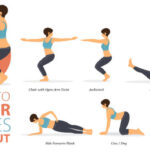What is Yoga ?
Yoga is an ancient Indian tradition that utilizes various techniques to establish balance between the human body, mind, and soul. The literal meaning yoga practices is “unity” or “union.
It is a structured group of practices involving various techniques and methods to establish balance between the body, mind, and soul. Through yoga, individuals attain physical, mental, and spiritual development.
While there are several types of techniques for practicing yoga, it is appropriate for beginners to choose easy and simple yoga practices. In this section, we will discuss five such yoga practices that are useful for beginners.
Tadasana yoga practices (Mountain Pose):
Tadasana or Mountain Pose is a simple beginner practice of yoga! In this pose, you stand upright with your feet together and keep your hands raised upwards while breathing. This pose improves physical balance and develops introspection.

Bhujangasana yoga practices (Cobra Pose):
Bhujangasana or Cobra Pose is beneficial for strengthening the back and waist of the body! In this pose, you lie on your stomach and then lift your body with the support of your hands.

Vrikshasana yoga practices (Tree Pose):
Vrikshasana or Tree Pose is beneficial for improving physical balance and developing introspection! In this pose, you stand with one foot placed on the other and keep your hands raised upwards while balancing.

Uttanasana (Forward Bend Pose):
Uttanasana or Forward Bend Pose helps in reducing physical and mental stress! In this pose, you bend forward with your feet straight and try to touch your toes or the ground with your hands.

Shavasana (Corpse Pose):
Shavasana or Corpse Pose is an extremely important practice of yoga! It promotes meditation and inner peace. In this pose, you lie flat on your back comfortably, close your eyes, and focus your mind. It reduces physical and mental stress and provides peace to the mind.

Regular practice of these beginner yoga practices improves physical, mental, and spiritual health! Practicing yoga helps a person live a healthy and balanced life and provides a positive outlook!
Here are some FAQs yoga practices
What is yoga?
Yoga is an ancient Indian tradition that utilizes various techniques to establish balance between the human body, mind, and soul.
What does the word “yoga” mean?
The word “yoga” has a literal meaning of “unity” or “union,” signifying the integration of body, mind, and soul.
What are the benefits of yoga practices ?
Practicing yoga offers numerous benefits including physical fitness, mental relaxation, stress reduction, improved concentration, and spiritual development.
Are there different types of yoga practices?
Yes, there are various types of yoga practices, each with its own focus and techniques. Some common types include Hatha yoga, Vinyasa yoga, Bikram yoga, and Kundalini yoga.
What are some easy yoga poses for beginners?
Easy yoga poses for beginners include Tadasana (Mountain Pose), Bhujangasana (Cobra Pose), Vrikshasana (Tree Pose), Uttanasana (Forward Bend Pose), and Shavasana (Corpse Pose).
How often should one practice yoga?
It is recommended to practice yoga regularly for optimal benefits. Starting with a few sessions per week and gradually increasing frequency is a good approach.
Can yoga help with stress reduction?
Indeed, yoga is renowned for its stress-relieving benefits. By incorporating practices such as deep breathing, meditation, and relaxation techniques, yoga becomes a powerful tool for reducing stress and promoting mental well-being. Transitioning from the physical postures to the more introspective aspects of the practice, individuals can cultivate a sense of calm and inner peace. Consequently, as practitioners engage in these mindful activities, they gradually release tension from both the body and the mind, fostering a greater sense of balance and tranquility. yoga practices Thus, through the integration of these techniques, yoga offers a holistic approach to stress management, providing individuals with effective tools to navigate life’s challenges with resilience and ease.
Is yoga suitable for everyone?
Yes, yoga can be practiced by people of all ages and fitness levels. However, it’s advisable to consult with a healthcare professional before starting any new exercise regimen, especially for individuals with pre-existing health conditions.
What are the benefits of each specific yoga pose mentioned in the article?
Each yoga pose mentioned in the article offers specific benefits, consequently enhancing overall well-being. For instance, Tadasana improves physical balance while Bhujangasana strengthens muscles. Similarly, Vrikshasana reduces stress and Uttanasana enhances mental focus. Finally, Shavasana promotes relaxation thus providing a holistic approach to health.
How can yoga contribute to overall health and well-being?
Regular practice of yoga contributes to overall health and well-being through a variety of mechanisms. Firstly, it enhances physical fitness, fostering strength, flexibility, and balance. Additionally, yoga cultivates mental clarity, sharpening focus and improving cognitive function. Moreover, it fosters emotional balance, helping individuals manage stress and cultivate resilience. Lastly, yoga facilitates spiritual growth, nurturing a deeper connection with oneself and the world around us. In sum, yoga serves as a holistic practice, nurturing the body, mind, and spirit for optimal health and well-being. It helps individuals lead a healthier and more balanced lifestyle.



